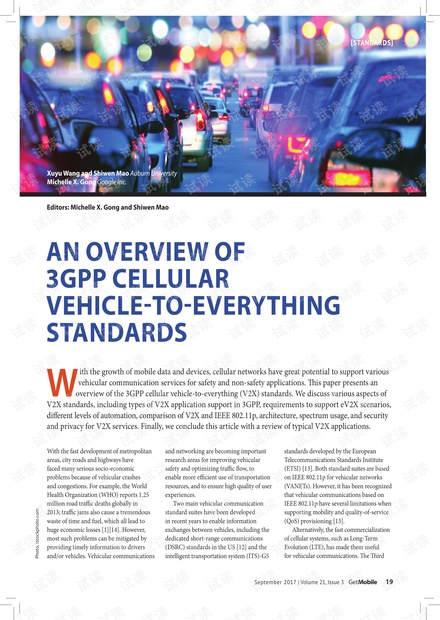
GetMobile
September 2017 | Volume 21, Issue 3
20
Generation Partnership Project (3GPP) has
been developing standards for the cellular
based Vehicle-to-Everything (V2X), aiming
to o er more e ective solutions for vehicular
communications. Compared with IEEE
802.11p, cellular based V2X can provide
better QoS support, larger coverage, and
higher data rate for moving vehicles [15].
Moreover, device-to-device (D2D) underlay
communications in LTE can be leveraged for
cellular based V2X applications with high
reliability and low latency [15].
In this paper, we provide an overview
of 3GPP cellular V2X standards. e
remainder of this paper is organized as
follows. Section I discusses the types of V2X
application support in 3GPP, while Section
II introduces categories of requirements to
support eV2X scenarios. In Section III, we
review di erent levels of automation, while
in Section IV, we compare V2X with IEEE
802.11p. In Sections V and VI, we discuss
the architecture and spectrum usage for
V2X services, respectively. We examine
security and privacy issues for V2X services
in Section VII, and introduce typical
V2X services in Section VIII. Finally, we
conclude this article in Section IX.
I. TYPES OF V2X APPLICATION
SUPPORT IN 3GPP
As shown in Fig. 1, there are four more
speci c types of V2X application support in
3GPP, including Vehicle-to-Vehicle (V2V),
Vehicle-to-Pedestrian (V2P), Vehicle-
to-Infrastructure (V2I), and Vehicle-to-
Network (V2N) [2]. By employing “co-
operative awareness,” the above four types
of V2X applications can be jointly used for
smarter services for end-users. For example,
vehicles, pedestrians, application servers,
and road infrastructure can obtain local
environmental information by receiving
messages from sensors in proximity or
other vehicles, to enable more intelligent
services such as autonomous driving,
vehicle warning, and enhanced tra c
management. We discuss these four types
of V2X applications in detail below.
1. V2V applications: V2V applications
allow surrounding devices to exchange
useful information by broadcasting, which
requires the user equipment (UE) to
subscribe to a network operator and obtain
authorization. V2V applications expect
UEs to transmit messages carrying V2V
application information, such as tra c
dynamics, location, and vehicle attributes.
To adapt to the varying amount of V2V
application information, the message
payloads should be exible. Additionally,
3GPP transport of messages can be
predominantly based on broadcasting. If
the direct communication range of V2V is
limited, the transported information can
be forwarded by infrastructure-based V2V
communications, such as roadside units
(RSU), application servers, and so on.
2. V2I applications: V2I application infor-
mation is transmitted from a UE supporting
V2I applications to an RSU or locally rel-
evant application server. en, the RSU or
application server can choose the received
UE information based on di erent trans-
mission modes, such as broadcast, unicast,
and multicast. Also, the RSU or application
server can transit messages to one or more
UEs supporting V2I applications. A locally
relevant application server serves a particu-
lar geographic area, while multiple applica-
tion servers can serve overlapped areas,
with the same or di erent applications.
3. V2P applications: V2P applications
are similar to V2V applications, and the
V2P service information is exchanged
between pedestrian UEs and vehicular
UEs. V2P application information can be
transmitted by a V2X UE in a vehicle to
warn a pedestrian, or by a vulnerable road
user UE to warn a nearby vehicle. Di erent
from V2V, a pedestrian UE supporting V2P
applications usually has a lower battery
capacity, and the radio sensitivity will be
lower than vehicular UEs because of the
antenna design. erefore, a UE supporting
V2P applications cannot send messages
as frequently as UEs supporting V2V
applications.
4. V2N applications: A UE supporting
V2N applications can communicate with
the application server supporting V2N
applications, while the parties communicate
with each other using Evolved Packet
Switching (EPS). V2X services are required
for di erent applications and operation
scenarios.
II. ENHANCEMENT OF 3GPP
SUPPORT FOR V2X SERVICES
(EV2X)
3GPP speci es the Enhancement of 3GPP
support for V2X services (eV2X) in the
following four areas: (i) Vehicles Platooning;
(ii) Advanced Driving; (iii) Extended
Sensors; and (iv) Remote Driving [3], which
are discussed in this section.
In the case of vehicles platooning, vehicles
can automatically join a group of vehicles
traveling together. e vehicles in the platoon
can obtain periodic information from the
leading vehicle for carrying on platoon
operations, such as keeping the gap between
two adjacent vehicles small (e.g., as small as
a sub second). Moreover, the vehicles can
operate in a distributed manner in platooning
applications. eV2X supports vehicle
platooning, information exchange within
the platoon, automated cooperative driving
[
STANDARDS
]
FIGURE 1. Four types of V2X application support in 3GPP (i.e., V2V, V2P, V2N and V2I).
Vehicle
Vehicle
Pedestrian
RSU
Application
Server
V2V
V2I
V2P
V2N








 我的内容管理
展开
我的内容管理
展开
 我的资源
快来上传第一个资源
我的资源
快来上传第一个资源
 我的收益 登录查看自己的收益
我的收益 登录查看自己的收益 我的积分
登录查看自己的积分
我的积分
登录查看自己的积分
 我的C币
登录后查看C币余额
我的C币
登录后查看C币余额
 我的收藏
我的收藏  我的下载
我的下载  下载帮助
下载帮助 
 前往需求广场,查看用户热搜
前往需求广场,查看用户热搜

 信息提交成功
信息提交成功